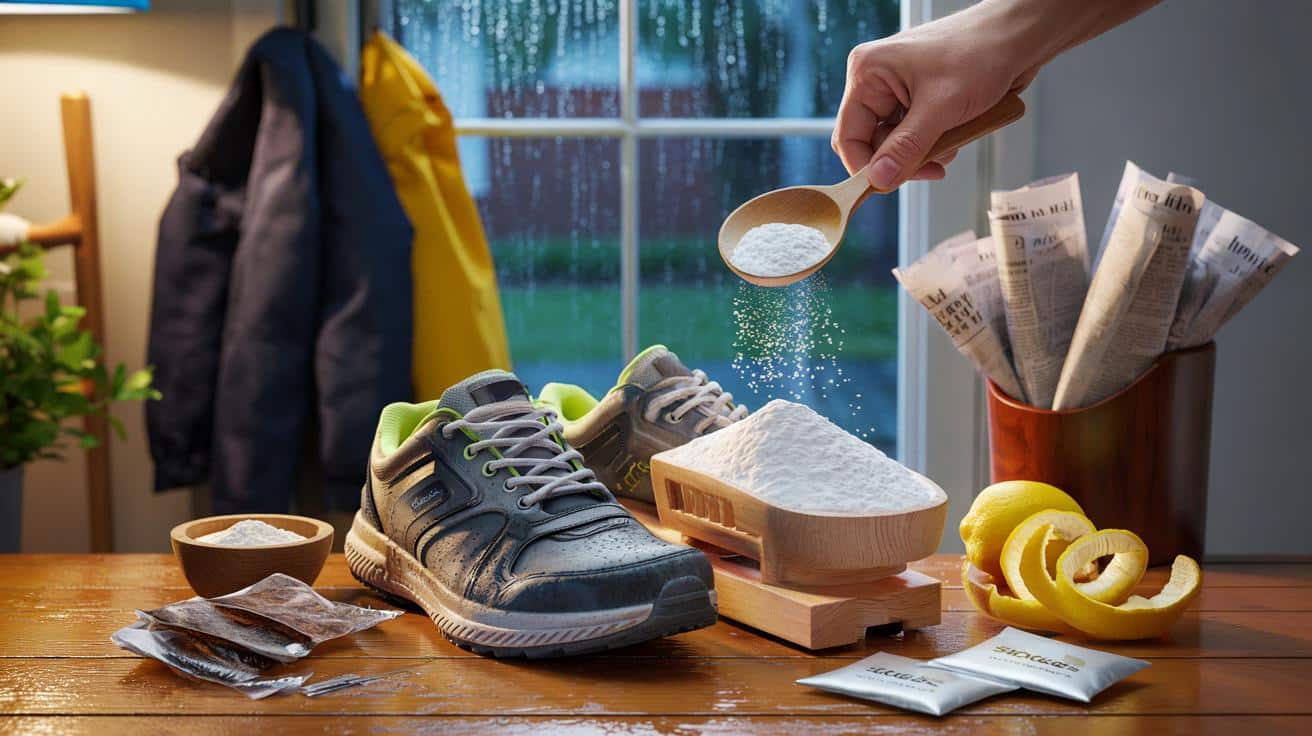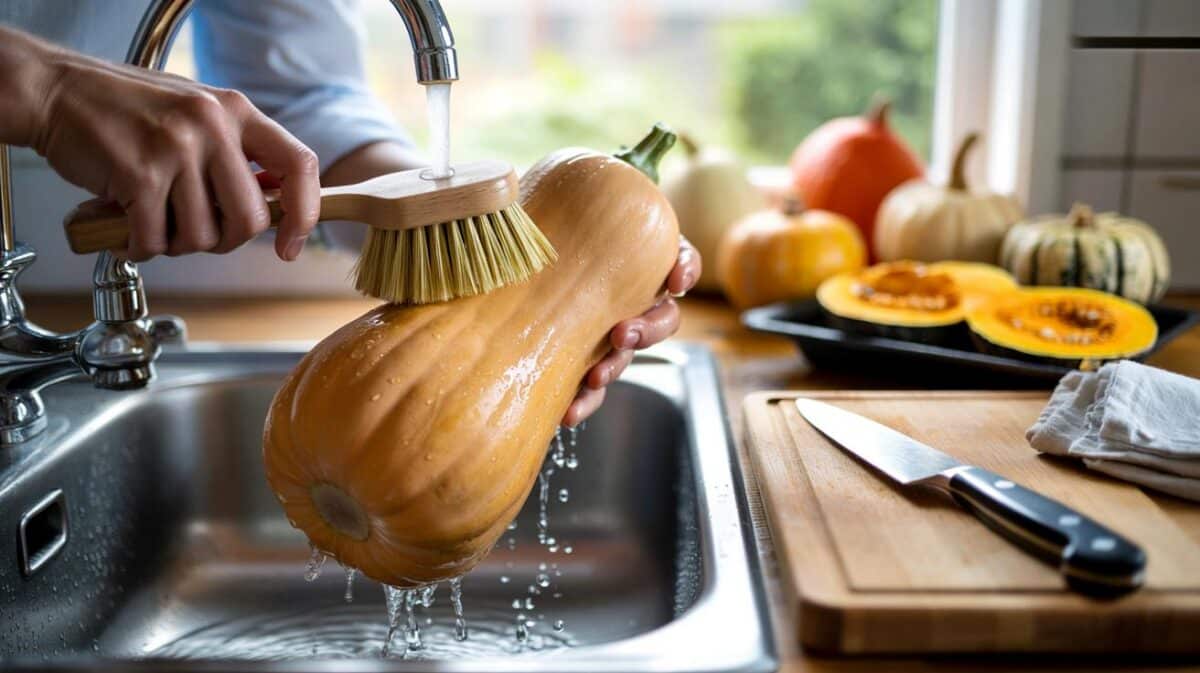This season’s colder mornings trap sweat in trainers and boots. Odour builds fast. Households want fixes that cost pennies and avoid harsh sprays. A simple routine using a common kitchen powder is gaining ground because it targets the cause, not the symptom.
Why shoes smell and when it gets worse
Sweat itself is odourless. Trouble starts when warm, damp fabric meets skin microbes. They break sweat down into acids such as isovaleric acid. That chemical “locker room” note then clings to insoles and linings.
Autumn creates perfect conditions. Rain soaks uppers. Heating goes on. Your feet stay enclosed for 10 hours or more. Synthetic socks trap moisture. Trainers with foam midsoles hold it. By evening, bacteria multiply and the scent greets you at the door.
Moisture plus warmth plus time equals odour. Remove any element and the smell fades within a day or two.
The cupboard powder that actually changes things
Sodium bicarbonate, better known as bicarbonate of soda, tackles shoe smell on two fronts. It absorbs moisture from fabric and foam. It also buffers acids produced by bacteria. That two-pronged effect limits both the environment microbes like and the compounds your nose hates.
Plain talc can help by soaking up damp, but it does not neutralise acids. Some people prefer arrowroot or maize starch if they avoid talc. You can use either with bicarb for a stronger overnight result.
Use one tablespoon of bicarbonate per shoe, leave overnight, tap out in the morning. Most pairs smell fresher in 24 hours.
Step-by-step: a 24-hour odour reset
- Remove insoles if they come out easily. Rinse them with lukewarm water and mild soap. Air-dry fully.
- Sprinkle 1 tablespoon of bicarbonate into each shoe. Tilt and tap to coat the toe box and heel.
- For heavy odour, add 1 teaspoon of talc or arrowroot on top to boost absorption.
- Leave the pair in a dry, ventilated spot for 8–12 hours. Keep them away from direct high heat.
- In the morning, tap shoes over a bin. Wipe any residue with a dry cloth.
- Slip the dry insoles back in. Wear with clean, natural-fibre socks.
This simple routine costs well under £2 per pair and works on trainers, school shoes, football boots and ankle boots. Repeat weekly in damp weather, or after workouts.
Three add-ons to try tonight if the smell lingers
Dry tea bags as moisture magnets
Used, fully dried black or green tea bags draw out residual damp. Pop one in each shoe after the bicarb stage. Tannins help inhibit bacterial growth. Remove before wearing.
Citrus peel for a clean, light scent
Fresh lemon or orange peel contributes a gentle fragrance. Limonene in the peel masks remaining notes without heavy perfume. Replace peel every 24 hours until the odour settles.
Low-temp insole wash
Machine-wash removable insoles at 30°C inside a laundry bag. This reduces bacterial load. Air-dry flat. Do not tumble-dry foam.
Target moisture first, then neutralise acids, then refresh scent. Layering these steps beats any quick spray.
Daily habits that keep trainers fresh
Rotate pairs so each shoe gets at least 24 hours’ rest. Foam dries slowly. Alternating breaks the moisture cycle that microbes need.
Change socks daily, more often after sport. Choose cotton, bamboo or merino blends. Natural fibres wick sweat away from skin and into the sock, not the shoe.
Loosen laces and open the tongue when you get home. Air moves through the toe box and speeds drying. A simple shoe rack with gaps improves airflow around soles.
After rain, stuff shoes with plain newspaper for 30 minutes. Replace once. The paper pulls moisture from deep foam layers. Then remove and let the pair finish drying in open air.
What actually works: quick comparison
| Method | Best for | Notes |
|---|---|---|
| Bicarbonate of soda | Neutralising acid odours fast | Use 1 tbsp per shoe overnight; tap out; safe on most materials |
| Talc or arrowroot | Heavy moisture after wet days | Add 1 tsp with bicarb; avoid inhaling dust; consider talc-free options |
| Dried tea bags | Residual damp and light odour | Use fully dried bags; remove before wear |
| Citrus peel | Fresh scent without perfume | Replace daily; do not use with delicate leather linings |
| Cedar shoe trees | Shape and drying overnight | Help prevent creasing; choose the right size |
When smell points to a skin problem
If odour returns within hours, look at your feet, not just your shoes. Cracked skin traps sweat and bacteria. Treat minor cracking with a urea-based foot cream. Dry carefully between toes after showers.
Peeling, itching and a musty smell can indicate athlete’s foot. Keep feet dry, wash towels hot, and wear flip-flops in communal changing rooms. If symptoms persist, speak to a pharmacist about antifungal treatments suitable for you.
Care for different materials without damage
Leather needs gentle drying. Avoid radiators. Stuff with paper and let it breathe. Nourish uppers with a light conditioner once dry. Salt stains from winter pavements respond to a wipe of equal parts white vinegar and water, then a dry cloth.
Mesh trainers tolerate bicarb well. Keep powders away from exposed gel cushions or air units. For suede, dust lightly with bicarb and brush out with a suede brush once dry. Do not soak.
Make it a habit: a simple weekly plan
- Monday: rotate pairs; loosen laces at home.
- Wednesday: 1 tablespoon of bicarbonate per shoe overnight.
- Friday: wash socks at 40–60°C; air the shoe rack area.
- Weekend: low-temp insole wash; dry in shade; rest shoes 24 hours.
Small, repeatable steps beat occasional deep cleans. Most households can cut shoe odour within a week.
Extra tips that save money and time
Use silica gel packets from parcels to dry toe boxes after wet walks. A handful placed overnight speeds evaporation without heat. Store them in a jar and recharge on a sunny windowsill.
Keep a lidded tub of bicarbonate by the door with a measuring spoon. When you take shoes off, add a quick shake. This micro-habit stops odour before it starts and costs pennies per month.
If you train hard, upgrade the routine
Football boots and running shoes collect mud and microbes. Knock off debris after each session. Rinse out insoles. Use bicarbonate that night. Consider a low-watt boot dryer for wet winter matches. Gentle airflow at room temperature shortens drying times and reduces smell without risking glue failure.
Track usage. Most trainers last 500–800 km. As cushioning breaks down, foam holds more moisture and odour. Retiring a pair on time often solves persistent smell and improves comfort.








